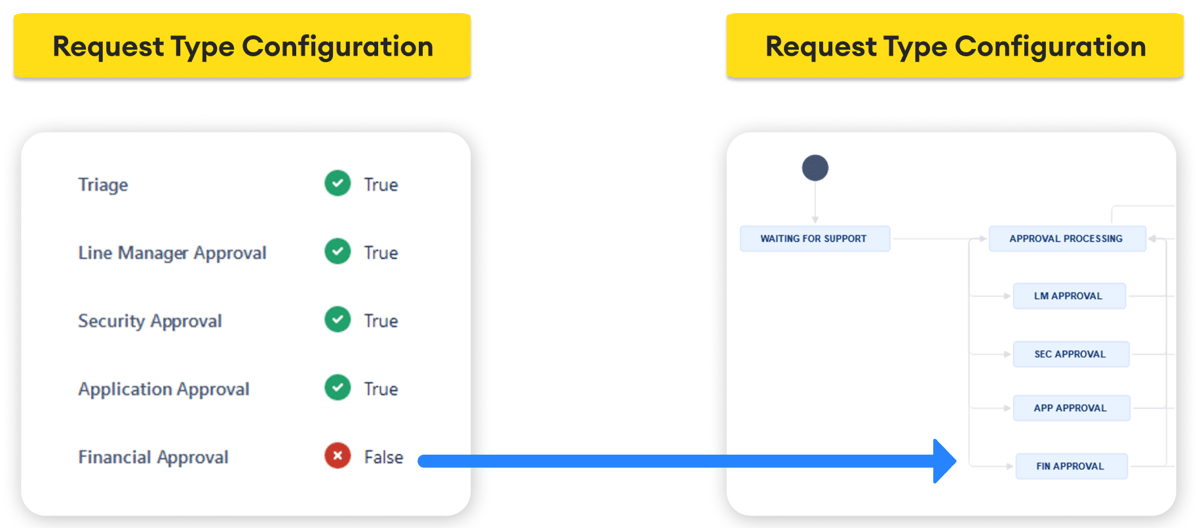Rugalmas munkafolyamat a kérések típusai szerint beállítva
Cégénél világos a cél: egyszerűsíteni szeretnék a munkafolyamatokat, és rugalmasabbá tenni őket anélkül, hogy folyamatosan az adminisztrátortól kellene változtatásokat kérniük. Egyszerűbben szólva, nem akarnaktöbb bonyolult munkafolyamatot kezelni. Biztosítson csapataiknak egyedi jogosultságokat a CMDB adatbázisukban a kérelem típusok létrehozására és konfigurálására. Ez ideális a feladatkörök szétválasztásának érvényesítésére különböző üzleti egységek között, miközben megőrzi a rugalmasságot.
KontaktÁllítsa be az egyes kérelemtípusokhoz szükséges munkafolyamat-lépéseket
Szerezze meg azt a rugalmasságot, amellyel projektenként be- vagy kikapcsolhatók a munkafolyamat-átmenetek és jóváhagyások a projekt igényei szerint. A projektadminisztrátor teljes mértékben kézben tartja a konfiguráció módosítását, amely azonnal alkalmazásra kerül a munkafolyamatokban, és nyomon követhető lesz az Atlassian Assets változási előzmények között.
Az elfogadó személy lekérése a kérő felhasználó szerint, beleértve a tartalék elfogadót
Amikor minden felhasználóhoz hozzárendeljük a megfelelő közvetlen felettesét, ezt az információt automatikusan felhasználhatjuk az elfogadó személy beállításához minden felhasználó számára. Ezt az információt leggyakrabban közvetlenül az EntraID-ből vagy egy másik eszközből szerezzük be egy központi CMDB-be.
A felhasználói profil információinak kiegészítése (például: cég- és helyszíni információk) révén globális tartalék elfogadókat is meghatározhatunk.
Ez a megközelítés lehetővé teszi bonyolultabb forgatókönyvek konfigurálását is: például jóváhagyás és csapat hozzárendelés a cég (jogi entitás) és/vagy az alkalmazott helyszíne alapján. Az emberi erőforrások szolgáltatásmenedzsment projektjeiben előfordulhat, hogy a kéréseket a központi csapat helyett a helyi HR üzleti partnerhez kell továbbítani.
T
Empower your teams to manage their request types
Adja meg csapataiknak az egyéni jogosultságokat az Atlassian Assets-ben, hogy létrehozhassák és konfigurálhassák saját kérés típusaikat. Ez ideális a különböző üzleti területek közötti feladatkörökre vonatkozó elválasztás érvényesítésére, miközben mégis biztosítja a rugalmasságot.
Minden csapat saját kérés típusait konfigurálhatja anélkül, hogy aggódnia kellene amiatt, hogy mások módosítják a munkafolyamat viselkedését vagy az engedélyezési követelményeket.
Ez a megközelítés minden vállalati szolgáltatásmenedzsment csapat számára skálázható.
Kapcsolódó megoldások
IT szolgáltatásmenedzsment
Eszközkezelés
CMDB
Automatizált eszközfelderítés
Szoftver ehhez a megoldáshoz: Rugalmas munkafolyamat kéréstípusok szerint konfigurálva
STAGIL Assets (Advanced links management & Data model)
Jira Service Management
Assets Discovery
Szolgáltatásaink:
Tanácsadás
Örömmel nyújtunk részletes és személyre szabott konzultációt az Atlassian termékeiről illetve kapcsolódó szolgáltatásainkról.
Testreszabás
Egyeztessen tapasztalt tanácsadóinkkal, hogy a lehetőségeket közösen kiemelezve a legoptimálisabb beállítást találjuk meg.
Támogatás
Akár új az Atlassian világában, akár csak egy plusz segítő kéz kell - mi szívesen segítünk.
Fejlesztés
Olyan speciális funkciókra van szüksége, amelyeket egyetlen létező alkalmazás sem fed le? Mi az egyedi igényekhez igazodva lefejlesztjük a szükséges kiegészítőt.
Hosting
Több különböző szolgáltatási szinttel, és akár 99,9%-os elérhetőséggel segítünk elérni az Ön számára szükséges rendelkezésre állást.
Oktatás
Kisebb csapatok (8 főig) részére privát képzéseket nyújtunk akár online, akár Önökhöz ellátogatva.
Licencek
Vonzó csomagokat, illetve licencelési tanácsadást kínálunk az Atlassian előfizetések vásárlása vagy meghosszabbítása kapcsán.
Optimalizáció
Stabilizáljuk az Önnél futó Atlassian rendszereket és gondoskodunk róla, hogy mindig hibátlanul működjenek!
Az ön kapcsolattartója:

Szakértelem:
Atlassian Licencek, App Licencek, Tanácsadás
